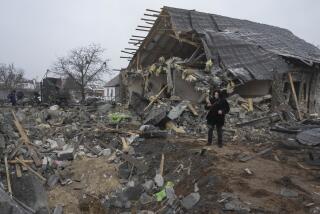Op-Ed: Putin’s belligerence today has its roots in the fall of the Berlin Wall

To those old enough to remember the frostiest days of the Cold War, today’s headlines and images seem very familiar. Military troops under the control of Moscow cross borders with impunity. Heads of NATO states struggle to generate an effective response. It’s hard not to ask, “How did we end up here again?”
The seeds of today’s problems were sown when the Berlin Wall fell, 25 years ago today, on Nov. 9, 1989. To understand why, contrast what happened as the Cold War ended with what happened after World War II. In 1945, Washington and its allies sought to incorporate as much of its main enemy, Germany, as possible into the West. After 1989, however, the strategy could not have been more different.
As summarized by Robert Gates, a future Defense secretary who was deputy national security advisor in 1990, the plan was simple: “Bribe the Soviets out.” And a young(ish) KGB agent named Vladimir Putin witnessed the success of that strategy firsthand from his post in East Germany.
Once-secret historical evidence shows that President George H.W. Bush, working closely with the West German chancellor, Helmut Kohl, left Moscow on the political periphery of post-Cold War Europe by design. Repeated calls by the Soviet leader, Mikhail Gorbachev, to include Moscow in European security institutions after the wall fell — or even for the Soviet Union to join NATO — were quickly and definitively rebuffed.
The evidence now available shows that the decisive negotiations played out largely behind closed doors in 1989 and 1990. Publicly, U.S. officials spoke of a “new world order” and maintained that their actions were guided by a regard for the dignity of the Soviet Union.
Privately, however, Bush spoke plainly to Kohl. Discussing the idea of Moscow having a say in unified Germany’s future relationship with NATO, presidential library documents and memoirs show that Bush was blunt: “To hell with that. We prevailed and they didn’t. We can’t let the Soviets clutch victory from the jaws of defeat.”
The American strategy of bribing Moscow out in the wake of 1989 went like clockwork. Washington even got Bonn to pay the “bribes,” which weren’t all that generous. The Soviet Union withdrew from divided Germany for little other than interest-free credits from West Germany. There was no formal guarantee against NATO expansion, and the money soon disappeared amid the chaos and corruption of the early 1990s in the disintegrating Soviet Union.
At first, marginalizing Moscow paid off for Washington. It obviated the need for longer negotiations over Moscow’s future role in European security at a time when chaos in the Soviet Union would have made such talks difficult. It contributed to the rapid freeing of Eastern Europe from Soviet domination, a triumph of political freedom. But, as former Secretary of State James Baker has rightly said, “Every achievement contains within its success the seeds of a future problem.”
That hidden problem becomes apparent when we consider how different Europe might look today if, after World War II, U.S. leaders and their European allies had approached West Germany with a “to hell with that, we prevailed” attitude. Not that Western leaders in the 1940s and 1950s pursued a path of integration out of pure altruism toward the defeated. Fear of Moscow’s intentions concentrated minds in the West and encouraged such cooperation where there might not have been any. But, whatever its motivations and flaws, the integration strategy brought an end to decades of violent conflict in the heart of Europe. No one today fears a military conflict between Germany and its European neighbors, despite the serious and violent struggles once again taking place on European soil.
In contrast, worry about renewed military conflict with Russia is now a front-of-mind concern for policymakers in Washington and Europe — not least because there are few other means for dealing with Russia. Because Washington pursued a strategy of exclusion, not integration, in 1989, a rare window of opportunity for cooperation between former enemies closed, unused, and will not reopen in the foreseeable future.
These events in no way excuse Putin’s actions today. Russia under his leadership has experienced de-democratization, censorship and rising homophobia and xenophobia. Its neighbors have endured aggression, energy shut-offs and armed incursions. The idea of integrating Putin’s Russia into any significant Western alliances or political structures is now undesirable and unwise.
But as a result of Washington’s 1989 strategy, the West has few political means, as opposed to forceful options, for resisting Putin. Put differently, 25 years later the West should indeed celebrate its contributions to greater freedom in Europe. But it should also be wary of simple self-congratulation. The years 1989 and 1990 were a time when Washington skillfully relegated Moscow to the edge of Europe. It needs to remember the long-term costs associated with that success as well.
Mary Elise Sarotte, professor of history at USC and a visiting professor at Harvard University, is the author of “The Collapse: The Accidental Opening of the Berlin Wall.”
Follow the Opinion section on Twitter @latimesopinion
More to Read
A cure for the common opinion
Get thought-provoking perspectives with our weekly newsletter.
You may occasionally receive promotional content from the Los Angeles Times.






